
NDphung
-
Posts
48 -
Joined
-
Last visited
Content Type
Profiles
Forums
Events
Blogs
Gallery
Posts posted by NDphung
-
-
8 minutes ago, Danne said:
I try to share when I can. When it comes to some parts of leathercraft, fine leathergoods in particular, there is so much that are kept secret. I’m in no way an expert, but I have learned a lot of techniques over the years, and if I can help someone I will.
Thanks again for all the advices you share. It was extremely helpful. As a hobbyist my number one struggle is finding time between Job, Family and social commitments, Keeping physically healthy and other mundane obligation and time for leathercrafting.
I am lucky this to arrange some time this year to visit two leather tanneries; 1) Wickett & Craig in Curwensville PA (I am visiting a relative 3 hours away) 2) Horween in Chicago IL (wife work conference). I will try to learn the basics of the material we work with.
-
7 hours ago, DieselTech said:
Yeah everybody I've talked to, says they love their KSBlade chisels & pricking irons. Stupid priced thou for a full set. Lmao what ain't expensive anymore. Even McDonald's!
Everybody I've spoke to, thinks the KSBlade chisels really refined their stitch work.
If you have access to Instagram, there is an australian leatherworker: carswell_leather , who is not a big fan of KS Blade. He posted on June 23, 2021 a small video where he shows the pricking irons he has and used. He has Kevin Lee, KS Blade, Amy Roke, Wuta and 4Z. He prefers Amy Roke over the KS Blade. Because the thick body above the teeth (similar to Sinabroks, offshoot of KS Blade both Korean) blocks the view of the teeth from above.
I also saw a video where the thick body that protrudes from the handle above the teeth bumps against the round body of a briefcase handle when he tries to prick the leather under the handle.
I think it all comes down to personal preference. You need to carefully match your need and aspiration (what you plan to do) to your constraint (KS, Amy Roke ain't cheap).
The list of Pricking Irons I looked at is Huge: KS Blade, Sinabroks, Amy Roke, Kevin Lee, Crimson Hide, JunLin, Pro Atelier Plus, Rocky Mountain Leather, ZJ Handiworks, Jayme, Beagle, Doldokki etc. It is very hard to choose.
I personally have a set of Junlin/Leatherworkschool Collaboration and Rocky Mountain leather. Mainly for their price.
-
22 minutes ago, Danne said:
1. I have it clamed on my stitching clamp when I open the holes with my awl, it wouldn't work on a flat surface since the edges of the wallets interior are skived, so it wouldn't lay flat, and if it did I could instead punch all the way through with stitching irons.
2. I find that I get a more consistent result if I open up like the whole row of holes before I stitch, then I reposition the wallet to stitch another part, and first open those holes with an awl also. That way I feel more certain that I have the same angle all the time.
3. I first cut of the sharp tip, then I flatten it to an oval shape. A lot of people don't want to spend the time doing this and then Palosanto have awls that people seem happy with, and they are already sharp and have a good profile.
Thanks, I have not seen many crafters do it this way but I have seen your BiFolds and they are pretty spectacular so the result speaks for itself.
-
-
Sorry again for being late to this topic but previously I read that European Irons/Chisels are meant for marking only not punch through. I believe that most modern European(French) Irons/Chisels can be used to punch through to about 4-5mm thick leather (9-10 oz) with their slim and long teeth (ref. Kevin Lee, JunLin, KS,Sinabroks, ZJ, Beagle, Craft Jayme etc). I could be wrong please let me know.
I even committed the most sacrilegious act by punching through 4mm of combined French Chevre and reinforcement using a Vergez Blanchard #8 Pricking iron (the class was given by a French teacher to boot). I know that it should be strictly use for marking follow by the awl. but here is the result, The backside of a clutch I made (2 x 1 mm French Chevre + 2mm Reinforcement with Campbell's Satin Laid Linen thread 532 or 832 I forgot).
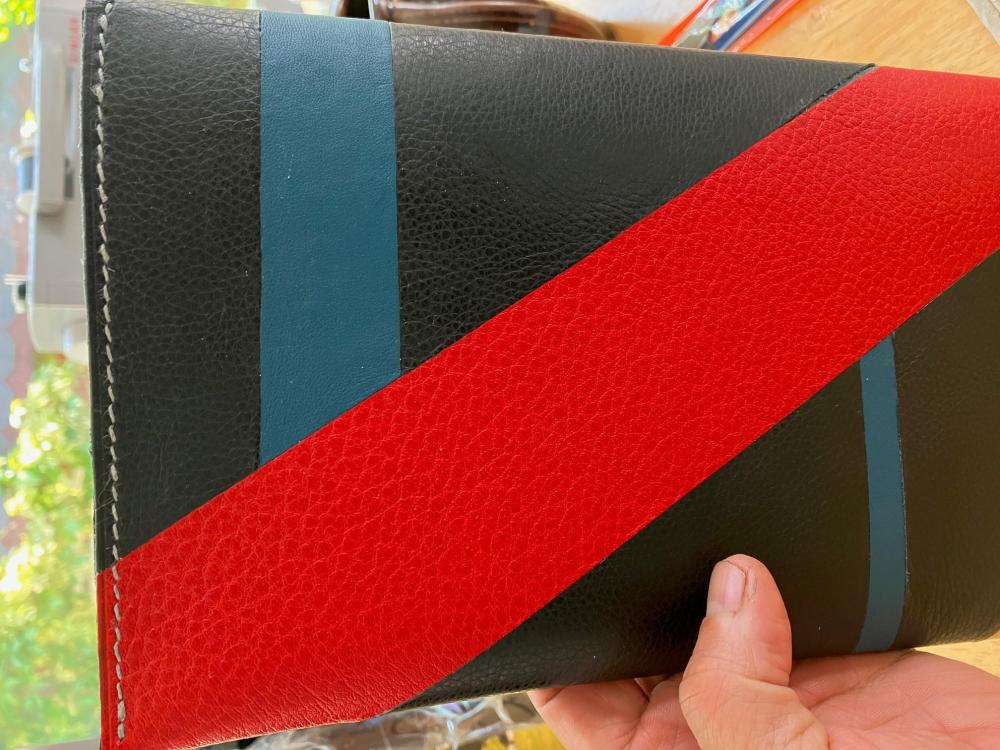 I will send front side (interior)
I will send front side (interior)
-
2 hours ago, Danne said:
Most of my wallets have their exteriors punched before glued to lining, and after fully assembled holes are opened with an awl. And it's not as hard as many people believe. I did struggle a lot at first, but when I finally learned how to sharpen my awl correctly, it didn't take that much practice to get straight holes. A wine cork on the back side can be very helpful to avoid distorting the leather. And if someone wonder why I use an awl for wallets, the reason is because i prefer stitching from the exterior side, and interior leather will have skived edges so punching all the way through is not possible (not with good results)
Thanks again for the tips, I will have to try this. May I have a couple of questions?
1) You use a wine cork on the backside, so do you clamp your wallet on a vertical stitching clamp? I have seen some crafters lay down their work on a flat rubber/cork surface and literally use an awl to go through the punched/marked holes from the top layer.
2) Do you stitch with an awl on your hand or you use an awl only to open the holes?
3) When you sharpen your awl do you keep its Diamond shape or you sharpen it to a straight blade?
Thanks for the great advices as always.
-
Following up on my previous about the OKA Diagonal (french style) and Diamond Chisel I manage to sew quickly for comparison. Note the leather is very low quality scrap leather.
From Left to Right
1) OKA 5mm Diamond w/ Ritza 1.0 mm and John James 002 aka #2 (It is actually the same size as #1 or #3 i.e. 1.02 mm DIA and 54mm Length)
2) OKA 4mm Diamond w/ Ritza 0.8 mm and John James 004 aka #4 (0.86 mm DIA and 48mm Length)
3) OKA 3.5mm Diagonal (French Style) w/Vinymo #8 System S+U #5
4) RML 3.85mm Diagonal (Euro Style) w/Vinymo #8 System S+U #5
5) JunLin 3.00mm Diagonal w/ Xiange #30 System S+U #7
6) OKA 3.00mm Diamond w/ Xiange #30 System S+U #7
Personally I don't think the OKA 3.5 mm Diagonal (discussed in earlier post is not too bad especially considering how cheap that chisel is compared to the budget RML or the Junlin. The biggest drawback is that the biggest they offer is 6 Teeth so If you have long stitch line it is far from ideal. Their 3.00mm Diamond is also a surprise because of the high SPI I expect worse performance but it holds its own. My wife (with a western background) loves the low SPI and the thick thread, I prefer higher SPI and thinner thread.
I would love to hear from all of you on the topics of chisel size and thread and needle selection.
-
Just now, Tugadude said:
Thanks. It is the first in the items on the page. I says "The Perfect Stitching: What Does It Require"
Yes
-
2 hours ago, Tugadude said:
Would be helpful if you could provide a link. I tried to look them up on Instagram but was unsuccessful. If they have helpful information it should be detailed here.
https://www.instagram.com/industrialdesignconcept/
I hope this work sorry I am pretty bad using the different platform.
It is one of their latest post for a contest. In the comment section you get many leathercrafters describe their favorite combination and sometimes their journey and evolution. I found it very informative.
-
On 10/24/2022 at 8:22 AM, Tugadude said:
Zuludog gave some great recommendations. Here is the topic thread he mentioned. Nigel Armitage's info pertaining to specific chisels and their use, along with the recommended needle and thread size is extremely valuable. I suggest you check it out. Very educational in my opinion.
Many leatherworkers like Ritza 25, also known as "Tiger Thread" due to the tiger on the packaging. I think the 0.6 and the 0.8 are particularly suitable for the type of work you are wanting to do.
Here also is the list of reviews from Nigel Armitage. If you check out his current videos he shows many of the chisels in action. You can also sometimes catch the "wall of chisels" in his workshop where they are on display. Quite the collection!
This might not be totally up to date, but you can check by going to his website.
file:///C:/Users/Peter%20Jaegers/Downloads/Armitage%20Stitching%20Iron%20Reviews.pdf
Good luck!
If you have access to Instagram there is a recent post by "industrialconcepts" who makes stamping machines and many great leathercrafters share their irons-thread size they use (Peter Nitz, Carswell Leather, Mila Jito etc.)
-
On 6/13/2023 at 1:35 PM, chuck123wapati said:
You mean the chisels stitch lines don't you Yea they are almost perfect. never the less if you don't have an awl and don't use one you have no experience to say if they make the job easier or not. Don't get me wrong i have used chisels for many years, even before i had an awl too!!! I used to think the way you did until I figured it out it but to each their own as you say.
I can only speak with my limited experience. I've been making a few wallet and passport holder and never even use a Diamond Awl as a lot of chisel/irons nowadays are made to punch all the way through. And the resulting stitch is pretty good on both sides. I recently took a formal Leather Marquetry class taught by an experienced leathercrafter (we have a formal leathercraft school here in Montreal, Canada with a 3 years leathercraftsman course) . She taught me the traditional way with an awl and a French Style clamp. The result was pretty awful. The stitch on the front side is OK but the backside is pretty crappy as you cannot see the other side with the clam between your leg and you have to poke through the leather with your awl). I understand that if you are making bags, or dealing with thicker leather, you have no choice but use an awl. But the learning curve is pretty steep. I found it easier to just punch through than mark with a pricking irons or wheels (that is what everybody used years ago) and lead with an awl to pierce the leather, If you make items which are not too thick.
-
On 6/17/2023 at 1:06 PM, Danne said:
Since this thread is quite old now, you probably already bought the tools you need, but I share my thoughts if someone else have the same question.
You wrote "I’d like to make small pouch-style projects for things like leatherman or Gerber multitools, as well as for various types of tool rolls."
I would say a good choice is LCDiamond from leathercrafttools https://leathercrafttools.com/tools/punch/stitching-chisel-pro/list/ or Seiwa, CraftSha, Kyoshin Elle or OKA from Goodsjapan (I wonder if OKA produce them all? just a wild guess, maybe someone know?)
and you want a thread that is strong, and suitable for outdoor use. Personally I would use Ritza (Tiger thread)
Hi, thanks Danne for sharing your advices. I second this advice as I did a little bit of research to chose my tool purchases. I happen to own OKA chisels both in Diamond Chisels and their "French style " chisels. Their "French Style" which they call Diagonal Hole Punch IS NOT a Diamond Hole Chisel (punch). It does not end in a point, it is a straight line so you need to align them like regular French Chisel.
I joined a picture of the differences in the hole they make. From Left to Right: 1) OKA 5.0mm Diamond Chisel , 2) OKA 4.0mm Diamond Chisel, 3) OKA 3.5mm Diagonal French Chisel, 4) RML 3.85mm French, 5) Junlin 3.00mm French 6) OKA 3.00 mm Diamond Chisel. This was made on 2.00mm Medium Firm Veg Tan leather. The top part is after the holes are tapped down before stitching.
As you noticed the OKA Diagonal French Chisel is very different from the other two but also very different from the Diamond Chisel. So I would not call it a Diamond Point or Chisel.
As far as the Original Post concerned you are quite spot on with your recommendation (knowing that you have experienced with Meisi thread). I started out like most leathercrafters with Diamond Chisel/Irons and Ritza thread. but I like now European/French Style with Meisi Xiange thread. Totally depends on what you do and the aesthetic you want to achieve.
-
-
I will absolutely follow your progress. you are a great source of information. I will try edge painting on veg tan leather this year so your selection will influence my first choice for sure. We have a leatherwork school in Montreal and I just took my first course in leatherwork. They use a French edge paint that I have never heard before; Stilz Have you ever heard of this paint company. hey seem to have an extensive leather paint selection?
-
I would love to share but I did not use any edge paint yet. I am researching before starting how to use it and I remember that I read a question/post on Peter Nitz site that stated that he doesn't use Filler (he uses Uniters I believe. I could be wrong
-
4 hours ago, Doc Reaper said:
Aside from sewing machines, stay away from “Made In China” , keep to the made in USA and vintage as stated. Do not use Etsy (mostly China garbage) get to know the folks on here, chuck123 is like Yoda, Wild Harry, and a few others are awesome. I have been doing leather for 51 years and still have questions
I agree with this 15-20 years ago. However for certain products Chinese made product now are excellent (if not better than USA). Take Pricking iron or chisel for truly hadmade products, There are no US made one and you can argue whether an Amy Roke or ZJ is as good as KS or Sinabroks (Korean) or Crimson Hides (Singapore). I believe Crimson Hides source the raw material from China then finish it inSingapore.
-
Beautiful, The Red is stunning you went 3.0mm punch did you also use # 30 Xiange. This I think personally is my favourite combination. My I ask at the end of the strap at the intersection of the two stitch lines, did you use a small round hole or you simply start with the other french punch? thanks
-
Very nice. Your stitching is very tight and regular. I would go with a contrasting thread or at least a subtle difference in color.
-
Danne was one of the first one I contacted on Instagram and he was extremely helpful with advices.
Fortunately, I have not any problem with social media (It helps when you don't many follower or friends on Facebook). My guideline for myself is simple. Life is too short for me to waist my time on free negative comments.
I use instagram mainly for Inspiration and keep up with the latest from some of the crafters I admire.
Ngoc Dung Phung
-
-
-
Very nice work, a couple of questions.
1) On your card holder, How do you make sure that your punch holes straddle the edge of the two pockets and arrived perfectly at the corner. Do you start from a set pattern? do you have to reduce sometimes the pitch from 3.0 to 2.7 to reach the corners or so you don't punch on the edge pocket? or do you use trim allowance and cut after the card holder edges after stitching?
2) On your watch strap, where the two stitching line meet (pointy end corner of the watchstrap) Is it a round hole punch? if not is it from the start of the top stitching line punch or is that the first punch from the bottom stitching line?
Thanks as always.
I would love to see and learn your watchstrap process from start to finish.
-
-
I want to throw in another option Meisi Xiange thread. It looks pretty good and waxed. It is very close to Vinymo. My personal likes and observation: Colors on Vinymo more vibrant and shiny (if you wax it before stitching, it will dull the color a litte bit). The MEISI Xiange is closer to Vinymo than Ritza, not as shiny as Vinymo and less waxy than Ritza. The Xiange looks as good to me as the Vinymo. One thing I like is the cute bobbin they come in if you order small quantity that bobbin design is really nice and fits well in my tackle box. This has nothing to do with the end result.
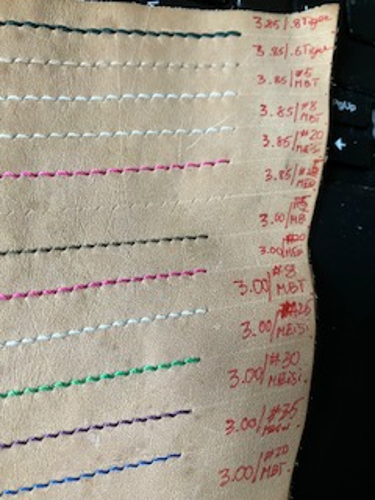
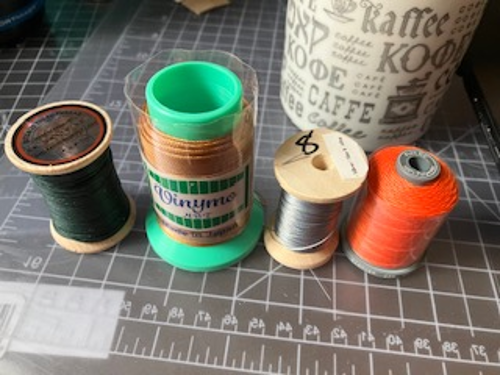
The Vinymo green spool contains the same 100 m thread as the grey Meisi spool even if it is almost twice the size (Far Left is RML 40m Ritza and in the middle is DLS 60m spool).
It is almost like Toyota and Honda, you will not go wrong with any of the three choices. There are differences but you just need to try them out and decide what pleases you most personally.



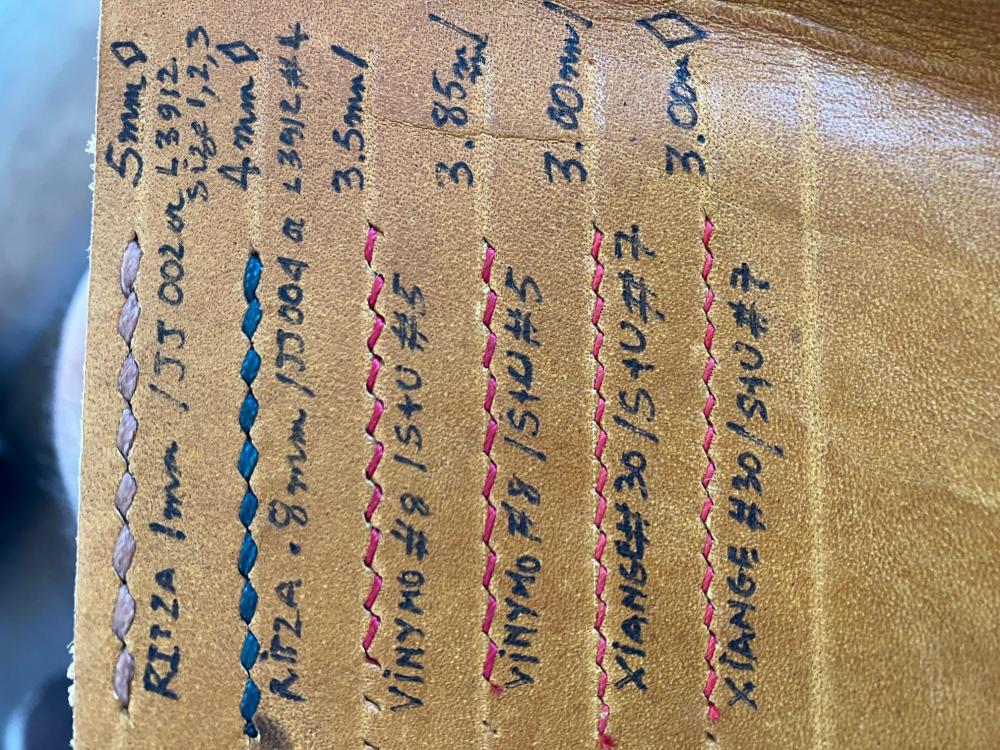

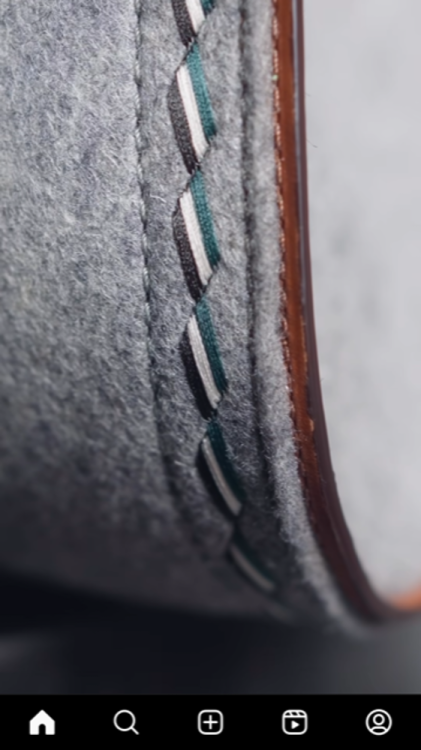
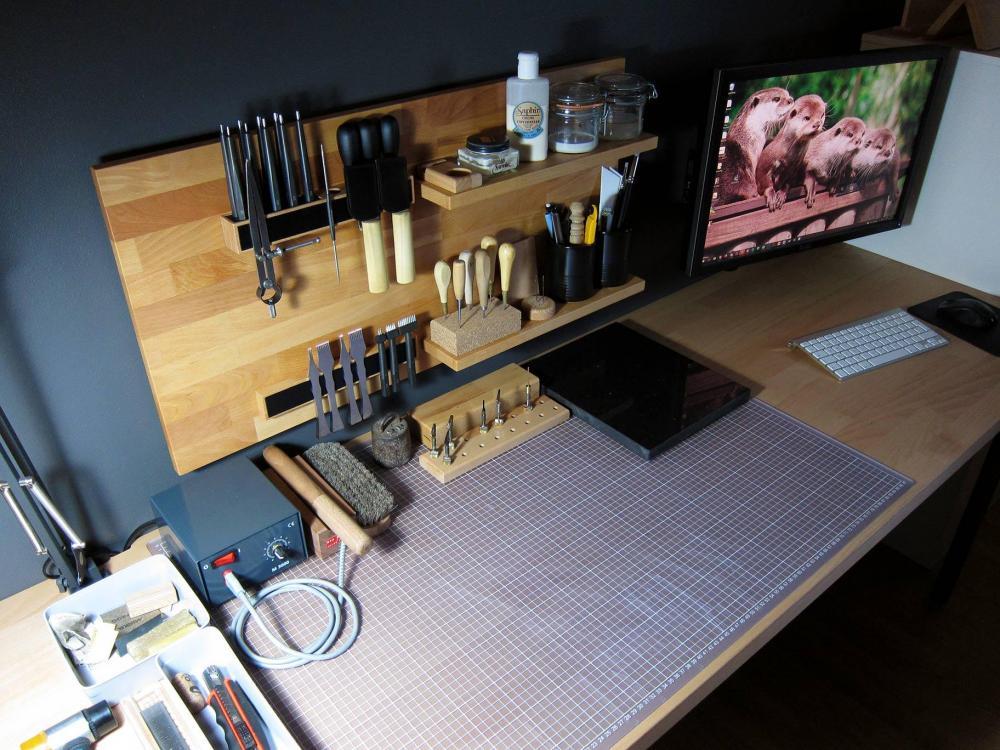

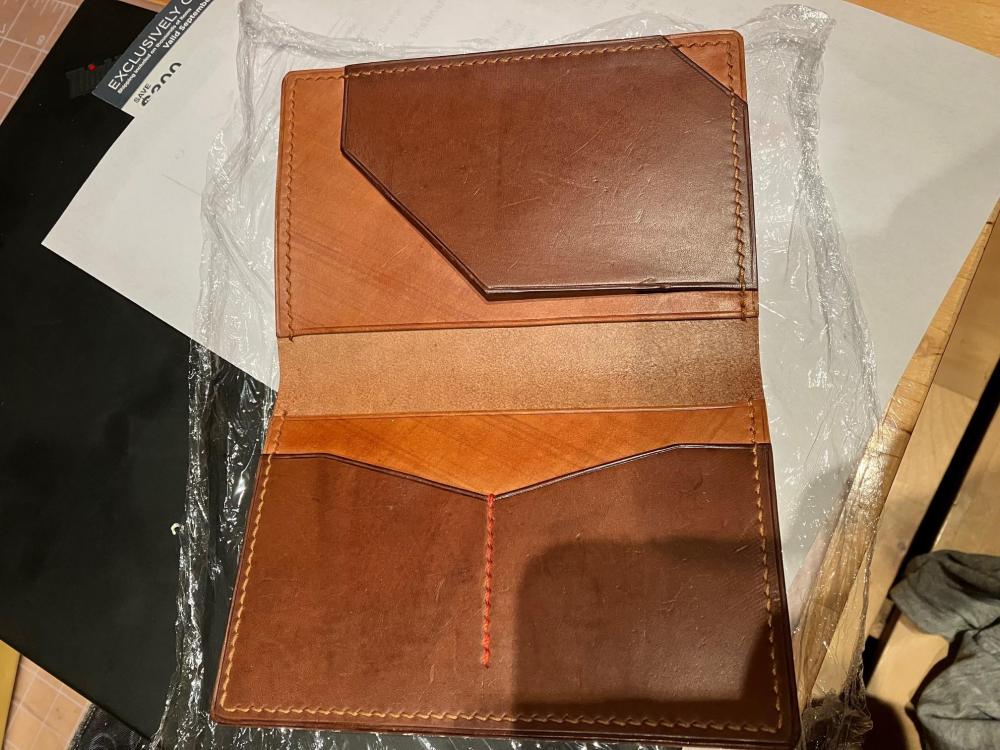
Watch Straps
in Other Specialties
Posted
150$ round knife? I think you can do as well with a NT or SDI cutter which will set you back for 20$.
Which size of Tandy Pro 2.7 or 3.0 (I believe made by Since) pricking Irons did you buy? Is the size of the Maine thread matches well with your irons size and thin enough for watch strap?
9-12 prongs would be ideal and easier to prick a straighter line.
Checkout a crafter from Belgium: Atelierdecoster on Instagram. He does very nice watchstrap